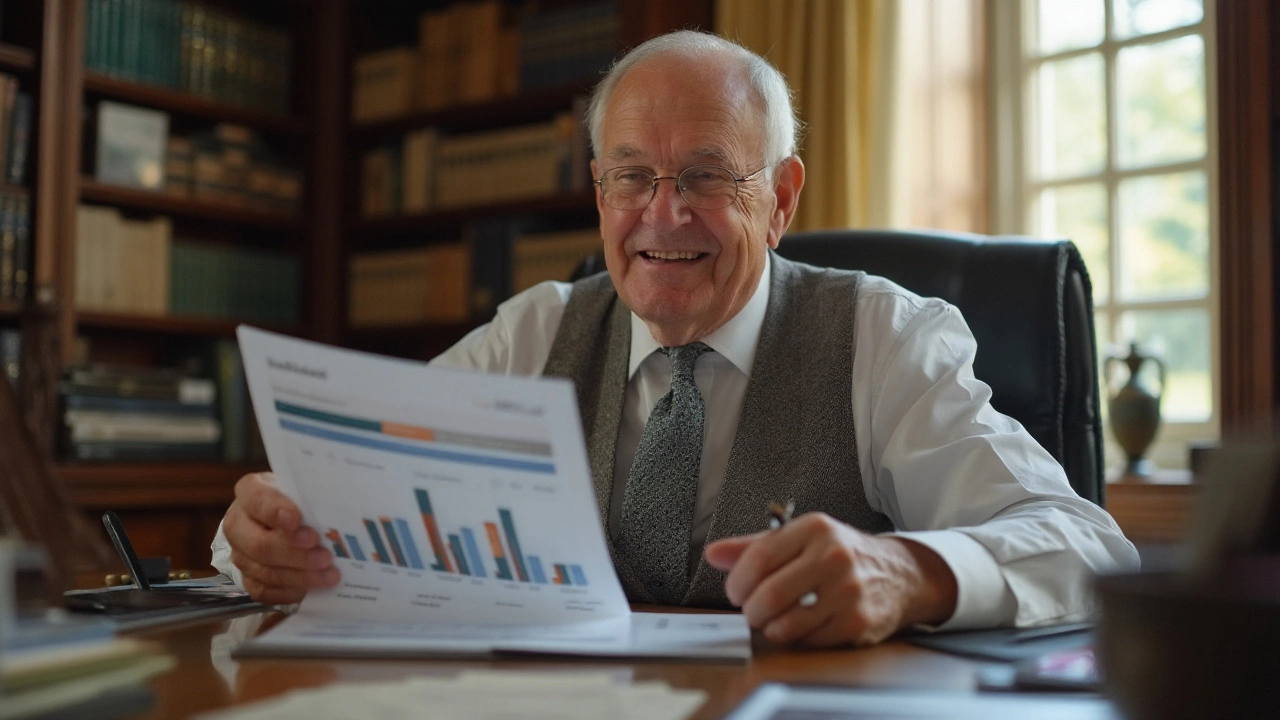Reaching the age of seventy is quite a milestone, not just for life but for investment strategies as well. Having $100,000 to wisely invest at this stage can bring both excitement and tension. It's crucial to approach this significant decision with an eye towards balancing both security and growth, tailored specifically for the golden years.
Investing in your seventies involves creating a financial cushion that assures stability while also catering to any desires for wealth growth. The art of investing at this age is not about aggressive risks but rather measured, savvy strategies. Let's delve into understanding how to make every dollar work while you enjoy life after seventy.
- Evaluating Financial Goals and Frequency
- Diversification in Senior Investment
- Balanced Risk with Fixed-Income Securities
- Exploring Real Estate and Alternative Strategies
Evaluating Financial Goals and Frequency
At any age, but particularly at seventy, achieving clarity in your financial goals stands as a cornerstone for smart investing. Understanding what you want to accomplish with your $100,000 is fundamental. Are you looking to preserve your wealth, generate a steady income, or perhaps leave a legacy for your loved ones? These questions are vital in shaping an investment strategy. Each goal can suggest different pathways; for instance, those aiming to preserve wealth may lean towards low-risk options like bonds, while others desiring income might explore dividend-paying stocks or real estate investments.
Determining the frequency of accessing these funds is equally crucial. Consider when and how you will need access to this money. If these assets need to be liquidated within a short timeframe to cover lifestyle expenses, prioritizing liquidity over high returns might be advisable. Reflect on domestic or health-related expenses that might arise suddenly, requiring immediate funds. Knowing the timeline over which you anticipate these financial activities gives tremendous clarity and peace of mind while planning.
As Warren Buffett wisely said, “Do not save what is left after spending, but spend what is left after saving.” This insight underscores the importance of budgeting and targeting financial goals at any life stage, emphasizing the significance of planning before making substantial financial commitments.
Moreover, when establishing your financial objectives, it is pertinent to take into account various lifestyle factors that significantly influence these decisions. For instance, your current state of health, existing debts, and whether retirement is already enriched with a comfortable pension should all play a role in setting your investment directions. Additionally, reviewing any financial commitments — like mortgages or supporting family members — that may still require attention will guide the allocation of resources with precision.
A thorough understanding of how market dynamics affect your investments is essential too, especially when managing retirement investments. Inflation is an omnipresent factor quietly eroding value over time. Historically, inflation rates have averaged about 3% per year in the United States, underscoring the necessity of investments that counterbalance these effects even as you prioritize safety and predictability. Incorporating awareness of economic trends ensures one's choices align with existing economic realities, protecting your wealth at a fundamental level.
Finally, engaging with a financial advisor who understands the unique challenges and aspirations that come with investing later in life can be immensely beneficial. They can offer personalized guidance by evaluating your retirement investment goals and ensuring they harmonize with your life's objectives. Personalized advice, drawn from insights about market trends and tailored to meet specific needs, can offer a competitive edge, transforming your financial goals from mere aspirations into tangible, prosperous realities.

Diversification in Senior Investment
Embarking on an investment journey at seventy with a substantial sum like $100k brings forth a fundamental principle: diversification. This age-old investment strategy remains a cornerstone of sound financial management, particularly for those in their retirement age. At this stage, avoiding concentration in a single asset class is imperative. Spreading investments across various asset classes helps mitigate risks while capturing potential returns. Today’s market offers a myriad of options to diversify one's portfolio, including stocks, bonds, mutual funds, and ETFs. Each brings distinct characteristics, enabling you to craft a portfolio that reflects your risk tolerance and financial goals.
Investors often turn to mutual funds and ETFs as they offer built-in diversification, with access to a broad mix of asset classes of varying risk levels. They provide an easy way for retirees to tap into equities, which, although more volatile, might yield high returns over time. On the less volatile end, bonds are another fundamental element, known for their stability and predictable income, crucial for those relying on a fixed income. They buffer against stock market vagaries, offering a more secure horizon. Experts often suggest a portfolio composed of balanced mutual funds to achieve that sweet spot, providing income as well as growth potential. However, ensuring this blend suits an individual’s unique financial circumstances is vital.
The world of diversification doesn't end here. Senior investors might even consider sectors beyond traditional markets, like real estate, which has shown resilience over decades. Investing in a Real Estate Investment Trust (REIT) could open the doors to real estate without direct property management responsibilities. Julian Robertson, a legendary investor, once emphasized,
“The way to maximize returns is to have a range of investments that dance to different beats of the market.”This quote underscores diversification’s essence – it's about assembling varied assets that react differently to market changes.
Finally, a diversified portfolio may include a slice of international exposure. While it's crucial to focus on the domestic market, international stocks offer exposure to emerging markets brimming with potential growth. As we live in a deeply interconnected global economy, avoiding a tunnel-vision approach benefits investors aiming for long-term gains. Many retirees tend to overlook the global landscape, but branching out occasionally leads to unexpected yet lucrative opportunities. The bottom line, then, especially when standing at the cusp of life's twilight, is ensuring your investments are far-reaching enough to weather storms yet adaptable enough to seize growth opportunities.

Balanced Risk with Fixed-Income Securities
When it comes to investing at 70, there's an undeniable value in grounding a part of your portfolio in fixed-income securities. These are like the solid rock that holds steady amidst the sometimes turbulent waters of market volatility. Generally considered to be less risky than stocks, fixed-income investments provide a predictable and regular income, making them an attractive option for retirees. Essentially, they are loans made by an investor to a borrower – typically corporate or governmental – and in return, the investor receives interest payments over time along with the eventual return of the principal amount.
These securities come in various shapes and sizes, including government bonds, corporate bonds, and municipal bonds. Each type offers unique benefits and potential drawbacks that are important to consider, particularly when seeking to diversify investment and manage risk at this stage in life. One popular choice, U.S. Treasury Bonds, are renowned for their safety and stability, often dubbed as one of the safest investments globally due to their government backing. They can be a wise choice for those looking to preserve capital while earning a modest return. Then there are corporate bonds, which tend to offer higher yields than government bonds, compensating for the higher risks associated with the company's financial stability. Municipal bonds, on the other hand, allow one to invest in local government projects and often come with tax advantages, adding another layer of benefit.
It's crucial to balance these options within the fixed-income category to align with personal risk tolerance and income needs. During this chapter of life, income generation becomes increasingly prioritized, and a well-rounded fixed-income portfolio can help achieve that without leaving the comfort zone. According to a recent AARP study, around 50% of retirees hold fixed-income securities in their portfolios, underscoring their widespread acceptance and reliability. This trend is driven by the reassurance of receiving a steady cash flow, which helps manage living expenses while still participating in the financial markets.
"Good bonds make for good households," financial advisor Lisa P. McGavin remarked during a recent finance summit, endorsing the peace of mind they can distribute.
Investing in fixed-income securities, however, isn't devoid of risks completely. Factors like interest rate changes can impact bond prices inversely. When interest rates rise, existing bonds with lower rates become less attractive, depreciating their value. Hence, keeping an eye on interest rate trends, particularly in times of economic shifts, is pivotal. Apart from this, inflation can erode the real return from interest payments over time. Still, many retirees find that the benefits of dependable income and low risk generally outweigh these challenges, providing a reliable financial foundation at this special time of life.

Exploring Real Estate and Alternative Strategies
Investing in real estate can be an attractive option for seniors looking to secure their financial future. Real estate not only offers the opportunity for regular income through rental properties but also holds the potential for appreciation over time. At age seventy, it's important to consider properties that require minimal maintenance, such as condominiums or townhouses, which often come with association management taking care of exterior upkeep. This allows for a more hands-off investment, which can be appealing during retirement.
For those considering real estate, another avenue is investing in Real Estate Investment Trusts (REITs), which can offer the benefits of real estate investment without the need to manage physical properties. REITs are companies that own, operate, or finance income-generating real estate, and they typically pay dividends to their investors. This creates a potential revenue stream while allowing for diversification in an investment portfolio. Did you know that according to Nareit, the average annual return of publicly traded REITs from 1972 through 2021 was 11.25%?
Peter Lynch, famed investor, once said, "Real estate is an imperfect investment class because it's not as liquid and easy to research as stocks are, but it's one that can really pay off with patience and smart investing."Alternative strategies might also include investing in annuities, which can provide stable, localized income. Annuities can come in many forms, but the core principle is to provide a regular and reliable income for the investor. These can serve as a safety net in times of market volatility, providing you the peace of mind knowing that a portion of your funds is secured in a dependable financial product.
There are other practical alternative investments like peer-to-peer lending, which involves lending a portion of your funds to individuals or small businesses. Though it does carry some risk, the returns can often be quite substantial, depending on the loan terms and the creditworthiness of the borrower. It's worth noting that Mugrich, a leading financial analyst research group, reports that the peer-to-peer lending market reached a new height, hitting $200 billion globally in 2023.
Lastly, consider the potential of investing in senior-friendly developments like assisted living facilities. With the population of seniors on the rise, there is a growing demand for such facilities, which can be a lucrative investment. Engaging in investments that bet on trends specific to the aging population can work favorably.
While exploring these strategies, it's crucial to consult with a financial advisor to consider the risks involved and determine how each avenue fits with your personal financial goals. By understanding the trial and opportunity involved with these strategies, investing at seventy doesn't have to be daunting, but rather an exciting new chapter filled with possibility.
